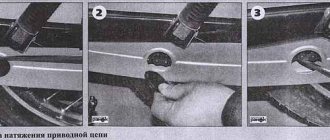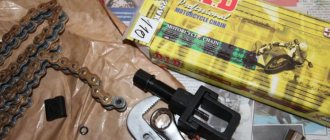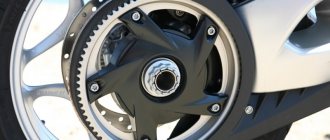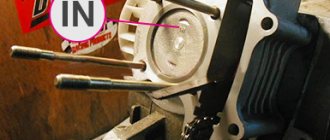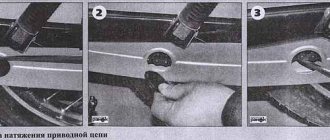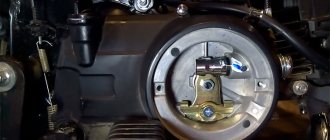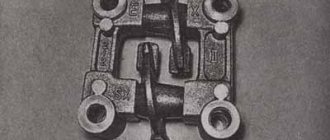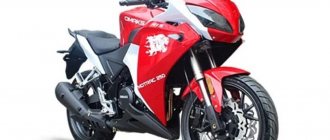It's no secret that for the long-term service of motorcycles, you should regularly inspect and, if necessary, adjust motorcycle parts, for example, tension chains.
A loose chain is the first sign of wear. To determine whether the chain needs tensioning, a test must be carried out. The Enduro should be installed on the side stand and freed from foreign objects, including panniers. This is done in order to eliminate the load on the suspension.
Tools such as a tape measure, ruler or caliper are suitable for measurement. The permissible loosening rate is indicated in the operating instructions, as well as on the motorcycle sticker. For enduro, the norm is a chain sag of no more than 50-55 mm. The chain is tensioned if the measurement results in a value that is not within the permissible range.
Examination
First, you should determine whether your chain needs tension - for this you need to take a control measurement.
The motorcycle must be placed on the side stand, removing panniers and other foreign objects from it. As a tool, you should take a tape measure, a ruler or a fairly large caliper. Make sure there is no load on the suspension and start taking measurements. Very often the question arises, how should the chain be tensioned to avoid accelerated wear of motorcycle components? It is best to check the operating instructions developed by the motorcycle manufacturer, since the standard indicator may be individual for a particular vehicle. If this is not possible, you should use average values equal to:
When checking, it may be discovered that the actual indicator is outside the acceptable range. In this case, it is necessary to urgently tension the chain to avoid motorcycle breakdown in the near future. In addition, it is worth performing another check, assessing the technical condition of the circuit. Gradually spinning the rear wheel, determine the degree of sagging at each point - if this indicator differs significantly, the part urgently needs to be replaced. If your chain is very stretched, but you need to get to a store or service center, then to adjust you need to choose a position with minimal slack.
000_moto_0811_070
After work, I often stop by an old friend’s workshop. The pleasant atmosphere and the opportunity to tinker with the hardware yourself are very invigorating. One day, a new snow-white R6 stops at the entrance and a young guy asks if the service is still working. As usual, he needed to check the chain tension and lubricate it. After 10 minutes, satisfied service workers shook hands with the equally satisfied owner of the Yamaha. “What a wonderful client,” I thought then, still not understanding why he didn’t do such a simple procedure himself.
Manufacturers of modern goods are purposefully turning us into white-handed people. We don’t wash our cars, we don’t wash our clothes, we don’t hem our clothes. Many people no longer cook food at home. And they are unlikely to prepare anything edible if all the restaurants in the area close. Simply because they have never done it. Moreover, some believe that wasting time on such nonsense is beneath them. Maybe so, but I am sure that a person should still have a choice. I may not do something because I don’t want to, but not because I don’t know how. It's worth knowing! Be able to ride a horse, be able to cook deliciously, be able to take care of your own home, be able to drive a car and motorcycle well and be able to maintain them.
The chain drive is one of the most loaded components on a motorcycle. In powerful motorcycles, the forces generated in it reach several tons. And when accelerating and braking, they change direction. This often happens very abruptly, and at this moment the chain experiences serious stress. If the chain is loosely tensioned (sags a lot), then at the moment of load change, this excess supply of chain will first be selected, and then, when its free play ends, a sharp blow will occur, harmful to all elements of the transmission. By the way, it’s also unpleasant for the driver to drive such a motorcycle that jerks whenever the gas is opened or closed, especially in a sluggishly creeping traffic jam. The second disadvantage of a sagging chain is that when the tension is weak, its unloaded shoulder tends to move in a straight line by inertia, which is why it rests imperfectly on the sprocket teeth, thereby wearing them and itself out.
Is it possible to tighten the chain so that it does not sag at all? No, because as the rear suspension operates, the distance between the drive and driven sprockets changes. And the tensioned chain will be subjected to enormous loads (stretch greatly) if you do not leave it with a little slack, which will be removed during suspension operation. (And the shafts with bearings with a tightened chain, I note, will have a hard time.) The reason is that the axis of the pendulum and the axis of the drive sprocket on most motorcycles are located at a distance from each other, so the maximum tension occurs approximately in the middle of the suspension stroke - when the axles of the secondary the gearbox shaft, pendulum and rear wheel lie in the same plane.
There are many ways to adjust chain slack. Shorten or lengthen the chain itself, increase or decrease the diameter of the sprockets, move the mounting point of the pendulum... When tuning racing motorcycles, all these methods are used. But the easiest way to change the chain tension is to move the rear axle mounting point along with the driven sprocket. It is this solution, familiar from bicycles, that is used on all motorcycles.
There are two basic ways to move the axle mounting point. The first one is linear. The motorcycle pendulum has longitudinal slots along which the axle moves. Additionally, tensioners are installed. They come in different designs, but have a common principle: when you turn a screw or nut, the axis moves along the slot, respectively, loosening or tightening the chain. You just need to figure out the direction. It is also important to understand that while the nut on the wheel axle is tightened, you should not turn the tensioners - they can only be damaged by stripping the threads (however, after completing the adjustment, it is not harmful to tighten them so that they do not unwind on the road). Therefore, the axle nut must be unscrewed first. There are always marks on the pendulum and tensioners to help maintain wheel alignment. But in any case, I recommend tensioning the chain more or less synchronously, alternately gradually tightening the right and left tensioners.
Tension
There are two main chain slack control mechanisms used by various manufacturers. The complexity of the procedure in both cases will be approximately the same, but it is worth paying attention to the basic recommendations related to tension. The durability of the transmission, as well as other important components of the motorcycle, will depend on the correct execution of such an operation.
Longitudinal movement
The most common system is one with longitudinal slots in the pendulum - they allow you to move the axle by adjusting the distance between it and the gearbox shaft. To complete the work you will need two keys - 17*19 and 13*14. Having placed the motorcycle on the center stand or suspension, use a large wrench to unscrew the wheel shaft mounts - this will significantly loosen it, which is a necessary condition for adjusting the tension. Next, you need to pick up a smaller wrench and unscrew the lock nuts on both sides of the wheel.
Now you will need to learn how to tension the chain - there are adjustment bolts on both sides that move the wheel along the slot. Strong tension on one side can cause the wheel to skew, resulting in the need to completely disassemble the rear swingarm. Therefore, experts recommend turning the bolts one by one, making 1–2 turns. Do not forget to periodically check the degree of chain tension by pulling it with your finger - you can overdo it, which will force you to spend a lot of time finding the right position. Some motorcycles use special tensioners; to set them to the optimal position, you need to move them with a screwdriver or simply move them by hand.
When you manage to find the optimal position for the rear wheel, you will need to secure it to prevent further movement. First, the locknuts are tightened, and only then the motorcycle axle is fixed. Carefully check that all connections provide the tightest possible fit and do not allow the wheel to move. After this, measure the tension again and try how the motorcycle behaves on the move.
Eccentric mechanism
Some manufacturers suggest using a more complex but reliable eccentric mechanism. Working with it is absolutely not difficult, but you will need more skill than in the option described above. Most often, an eccentric mechanism is used to regulate chain tension in one-sided cantilever pendulums, although there are exceptions.
It is very important to know how to make adjustments correctly - you do not need to unscrew bolts or locknuts to do this. The only tools you need to prepare are a large hexagon - its size is determined by each manufacturer individually and may vary depending on the specific model of motorcycle. By turning the adjusting screw, you move the axle along the eccentrically drilled hole, changing the degree of its tension.
Step-by-step instruction
- You can shorten the chain using a rivet, or by carefully cutting off the top head of the pin (rivet).
- Next, it’s worth starting to dismantle the decorative and protective plastic above the traveling star. Unscrew all retaining screws.
- To release the drive sprocket, it is necessary to unscrew the fixing bolt, which may require considerable effort. Do the same with the driven nut.
- It is necessary to loosen the tension bolts that separate the chain drive.
- Next, we take the hub nut and caliper screws.
- The freed chain can either be cut with a grinder or riveted. It is recommended to perform riveting, since this will make it easier to connect the old and new chains, stretch them around the working circle, and significantly save time on installation. To do this, take a wire or a special lock and connect the two chains.
- Install new stars. Important! When installing new parts, freedom in the movement of the stars may be observed. Inexperienced motorcyclists try with all their might to press the sprockets, however, this will lead to its rapid failure. This play is a correction for vibration and unevenness.
- Having put the chain on both sprockets, you can check a couple of revolutions in neutral to see how it works. If everything is good, rivet it tightly.
- After the chain drive is installed, it is necessary to adjust its tension level. To do this, use the two adjusting bolts on the left side of the pendulum. We remind you that this is an initial setting that will need to be repeated after 400-500 km.
Next, all that remains is to lubricate the chain and assemble all the protective elements. It is better to use chains from proven and reliable manufacturers. They will last longer and will not cause accidents on the road.
Additional actions
If you know how to tighten a motorcycle chain, it wouldn't hurt to check the condition of the sprockets and other transmission parts. If signs of significant wear are detected, they should be replaced immediately, since breakdowns of this type seriously affect the reliability and durability of the motorcycle transmission. If you find that the chain is very stretched, it is better to get rid of it immediately - especially if you like to ride at high speed or perform stunts by tipping the motorcycle onto its rear wheel.
In addition, when regularly tightening the chain, it should also be cleaned and lubricated. It is better to use special products in cans that are supplied under high pressure - they effectively wash away all foreign deposits and also penetrate into all internal parts of the chain drive, contributing to its effective lubrication. The procedures are also performed with the rear of the motorcycle raised, which allows you to quickly spin the wheel if necessary. There are also special devices for cleaning the chain. The device is fixed to the transmission mechanism of the vehicle, after which all that remains is to engage first gear and ensure a continuous supply of cleaning agent to the receiving tube.
The motorcycle is serviced approximately every 500–2000 kilometers, which ensures the reliability and durability of all mechanisms. Every time you clean and lubricate, you should check the degree of chain tension to prevent serious sagging. Experts say that on average, tensioning has to be done every 2–5 thousand kilometers, depending on the operating conditions of the motorcycle. It is worth completely changing the chain every 10–15 thousand kilometers, or more often with an aggressive driving style or with frequent off-road trips. Failure to comply with these deadlines leads to accelerated wear of the transmission and the approach of expensive motorcycle repairs.
Motorcycle chain drive
The chain drive of a motorcycle is the most common drive method, but its use is associated with a number of difficulties. A motorcycle is not a stationary machine. Even other types of motor vehicles that use a chain drive have fewer difficulties.
The chain drives the rear wheel, which in most cases is mounted on a swingarm. The pendulum is moving. As a consequence, the chain tension changes depending on the position of the pendulum . The point of greatest chain tension varies among different motorcycle models. With different loads on the rear shock absorber, when driving over rough terrain, and so on, short-term moments of chain overtension may occur, as a result, wear becomes uneven.
All this leads to the fact that correct adjustment of chain tension, especially a new one, is the most important factor when stretching a motorcycle chain. A chain that is too tight will always cause uneven stretching due to uneven wear.
Motorcycle chain with uneven tension. Tense state
Motorcycle chain with uneven tension. Weakened state
Features of motorcycle operation
“What Russian doesn’t like driving fast” - I think everyone has heard this phrase. Well, why not ride a motorcycle? What happens to the chain at this time?
So, imagine a motorcycle stands still, has two points of contact, two wheels (we won’t take into account the legs). When a gear is engaged and released, the driving sprocket begins to move while the driven sprocket is at rest. The drive chain at the top experiences a sharp tension . There is a well-known saying: “Water wears away stones.” In this case, the outer plates pull the roller, and a groove gradually appears at the place where they meet - the length of the chain increases.
A similar situation occurs with a sharp increase in gas while driving. Accordingly, this also leads to increased wear. The more wear in the joints, the more damage each “starting” of the motorcycle and sharp acceleration will cause, which means that the rate of chain stretching will increase.
It turns out that the wear of the drive chain is affected by the driving style of the motorcycle, and the force of the chain jerk is also affected by the power of the motorcycle. If you prefer an aggressive driving style, sharp acceleration, rough terrain, then it is better to choose reinforced chain options.
Many chain manufacturers make tables for their range of chains corresponding to engine volume. This is a conditional guideline; you should not focus on the upper limit.
Timely adjustment of the motorcycle chain
We won’t talk about how to adjust chain tension. There are many articles about this. In general, it is better to rely on the instructions or, as they often say now, the manual for adjusting the chain in a specific model and brand. Since the points of greatest tension in a loaded and unloaded state may be different, and the manufacturer must notify about this in the instructions.
Professional approach
Many motorcyclists treat chain tensioning as a routine procedure, during which significant tolerances can be made and the position of the rear wheel can be adjusted “by eye”. This approach when setting the required chain tension is unacceptable - all operations must be performed as carefully and accurately as possible, using special tools. If you want to extend the life of the chain and avoid severe wear on the transmission when using the motorcycle in extreme conditions, you should purchase a special laser gauge to set the optimal wheel position. In the most difficult cases, if you cannot understand the structure of the adjusting mechanism or cannot loosen it, you should contact the specialists of a motorcycle service station. They will carry out all the necessary work, providing you with a guarantee of the quality of the result and the reliability of the motorcycle.
Choosing a chain for a motorcycle
Without a chain, your motorcycle simply won't move.
The chain for a motorcycle is a very important element of its operation, although it is quite simple.
Motorcycles don't run without a chain. Chains are sold riveted at the manufacturing plant, or they can be open. These chains come with a link with a riveted lock. Riveted chains are considered more reliable. But manufacturers claim that the new locks are the most durable.
As long as the factory lubrication is maintained and used on the chain, the chain will not cause any noticeable problems. Moreover, the constant improvement of seal forms makes it possible to reduce friction forces.
Problems with the chain arise when the rules for operating motorcycles are not followed. What can happen? The chain may break and the rear wheel will jam. Damage to the motorcyclist's leg is also possible. Chains can stretch over long periods of use. A chain that is not suitable for the motorcycle will fail faster.
Cases when the chain must be replaced:
Table. Designation and application of motorcycle chains.
| Circuit designation | Where is it used? | Motorcycle model | Pitch, mm | Roller diameter, mm | Chain width, mm | Number of links, pcs. | Chain length, mm |
| 2PV-9,525-1800 | Motor transmission | “Izh-56”, “Izh-P1”, P2, P3, P4, Yu5, “Izh-Yu”, Yu2, Yu3, Yu4, Yu5 | 9,525 | 6,00 | 25,4 | 66 | – |
| PV-9,525-1200 | Same | M-105 MMVZ all models | 9,525 | 6,00 | 9,52 | 44 | 419,1 |
| PR-12.7-1820-2 | main gear | "Sunrise", "Java" | 12,7 | 8,5 | 7,75 | 112 126 | 1422,4 |
| PR-15.875-2300-2 | Same | Motorcycles, all “izhi” | 15,375 | 10,16 | 9,65 | 104 | 1651 |
Replacing chain and sprockets
To install a new chain or sprocket you will need:
- A set of stars and chains or individual elements;
- Tool for riveting and riveting chain drives;
- Set of open-end wrenches;
- Slotted screwdriver;
- Ratchet keys.
Difficulties can arise when calculating the number of links in your chain based on the number of drive and driven sprockets. Using special software, you can get the number instantly. Some programs work without rounding, which means that you yourself must round the resulting odd value up, and the fractional value down. Different models or configurations result in different numbers of links. Therefore, if you see somewhere that your motorcycle requires a certain number of links, check it again using the software.
Motorcycle final drive chain care
Proper care of the chain will greatly increase the period of its safe use.
Every five hundred kilometers it is necessary to lubricate the chain. This should also be done if you are caught in the rain. Carry out this procedure before leaving. And there is no need to skimp on oil. To do this, pour the oil into a small container and use a brush. The motorcycle is placed on a stand; the rear wheel must be rotated while lubricating the chain.
Warning. It is not advisable to apply a lot of oil to an open chain, since by attracting dust while driving, the chain will begin to wear out and squeak faster.
For open circuits, it is better to use an oil spray in the form of a can. And closed chains can be generously lubricated with oil.
Before lubrication, wash the chain, especially if it is dirty. To do this, you can use either a liquid sold specifically for this purpose or kerosene. After the chain has completely dried, you can lubricate it.
Pay attention to the rear wheel. If it is shifted to the side, the tension will be uneven. It should be remembered that the life of the chain is greatly influenced by how you ride your motorcycle. By accelerating at top speed, you contribute to rapid wear of the chain. The chain should not be too tight or too loose. This will damage the chain elements and shorten its service life. This is why it is so important to regularly check chain tension. You can find out how to tension a chain on a motorcycle from specialists or on our website.
The structure of the roller chain and its weak points
We have already talked about the design of the drive roller chain, so here we will only touch on general points. So, a roller chain consists of external and internal links. The internal link consists of internal plates and bushings pressed between them. The outer link consists of outer plates and press-fitted rollers. The mobility of the links is ensured by the movement of the roller inside the bushing. The roller is located on the bushing and rotates freely, ensuring sliding along the sprocket.
The service life of the drive chain depends precisely on the quality of the joints of the chain links:
- the better the pressing is done (no mobility) between the inner plate and the bushing, the outer plate and the roller, the less the chain stretches;
- The better the sliding of the roller inside the bushing (presence of lubrication), the less heating of the chain elements and their wear.
As long as there is lubrication between the bushing and the roller, the link has normal, natural mobility. But if there is a fact of rotation of the sleeve in the inner plate or the roller in the outer one, then friction, heating and increased wear occur. Thus, these are the weak points. Moreover, it should be noted. The larger the contact area between the roller and the plate (the diameter of the roller and the width of the plate), the bushing and the plate (the diameter of the bushing and the width of the plate), the lower the risk of rotation.
As a result of turning, the metal gradually wears out and wears out. Increasing the diameter of the holes in the plates by 0.1 mm (0.05 mm radius) per 100 links will increase the chain length by 5 mm. What if the hole in the plates increased by 1 mm on all 100 links? At 50 mm? But this is more than 3 links of a 5xx chain. Naturally, this is rather a utopian situation, but it is a good indication of weaknesses in the drive chain.
These are the consequences that can result from lack of lubrication, poor riveting of the rollers and pressing of the bushings. Naturally, the quality of the metal also matters. It is for this reason that chain manufacturers carry out local hardening of the metal in the area of the plate hole, and for the tightest connection of the bead with the outer plate, four-sided riveting is used.
So, chain elongation occurs due to gradual wear of chain elements . But this happens slowly.
Fragment of a comment on the forum
Motorcycle chain tension
To check the chain tension, rotate the wheel and observe the condition of the chain at maximum tension. Now place the motorcycle on a stand and check how much deflection the chain has. The normal position is when there are two to three centimeters between the two parts of the chain, upper and lower.
For qualified chain tensioning, you can contact a service center. But if you want, you can do it yourself.
The main thing is to strictly follow the established rules.
All operations have been completed. You can once again ride your motorcycle on an exciting journey without fear that it will let you down.
How to properly tension a chain on a motorcycle
Source
